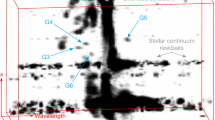Abstract
The star η Carinae, the most luminous known in the Milky Way galaxy, is a puzzling object. It is surrounded by a cloud of glowing gas that shows a distinct ‘pinched waist’ appearance, whose origin has been controversial. Morris et al.1 proposed that a massive but very compact torus of gas encircles the star, and that this caused the bipolar shape by preventing gas ejected by the star from expanding in the equatorial plane. Here we show that the small size of the torus (diameter of 5 arcsec) is insufficient to produce the observed infrared flux that inspired the conjecture. The dust giving rise to the 17-μm emission must be distributed over an area at least ten times the size of the torus. Such an extended structure of gas, however, would probably be incapable of generating the pinched waist.
Similar content being viewed by others
Main
As no suitable far-infrared images are available, Morris et al. based their hypothesis on features seen at wavelengths around 17 μm, where only a small fraction of the total flux is due to the cool 110 K dust in their model. The toroidal structure in question, marked in their Fig. 2, is a familiar feature in previous 2–18-μm infrared maps of η Carinae and has mid-infrared colour temperatures above 200 K (refs 2–8). A simple brightness–temperature argument shows that it cannot account for much of the cooler radiation seen in the data from the Infrared Space Observatory (ISO). At a wavelength of 50 μm, for example, the 110 K dust must produce a flux Fv≈22,000 Jy in their model (Fig. 1 of ref. 1). In order to have that flux at that wavelength, a 110 K Planck black body would need a projected area of 37 arcsec2.
But this is surely an underestimate, because the region must be optically thin at 50 μm for at least two reasons: first, Morris et al. assumed optically thin dust in their analysis of the spectral distribution; second, an opaque torus covering that area would be evident in visual-wavelength images. Thus, one can place a lower limit of roughly 100 arcsec2 on the extent of the cool dust component. The projected area of the torus, however, is only 5–10 arcsec2. Evidently that structure is far too small to account for the observed far-infrared flux. More complicated arguments involving heating of the grains, 17-μm intensities in the torus, and so on, lead to the same conclusion.
As Morris et al. emphasized, the ISO data seem to indicate at least 5 solar masses of additional ejecta, larger than the amount usually quoted for the bipolar ‘Homunculus nebula’ of ejecta from η Carinae9 (Fig. 1). We suggest that a viable model will have two characteristics. First, a continuous distribution of dust temperatures above 100 K is to be expected. This would fit the observed spectral distribution at least as well as the 110 K and 190 K components assumed by Morris et al., and may reduce the implied mass. Second, and more important, the cool 100–150 K dust is distributed much farther from the star than they proposed. Unshielded dust grains outside the homunculus are expected to have temperatures in that range. Existing far-infrared data provide little or no information on whether the cool dust is equatorial or not. We hope that future instruments will provide images at critical wavelengths beyond 30 μm.
References
Morris, P. W. et al. Nature 402, 502–504 (1999).
Hyland, A. R. et al. Astrophys. J. 233, 145– 153 (1979).
Mitchell, R. M., Robinson, G., Hyland, A. R. & Jones, T. J. Astrophys. J. 271, 133–142 (1983).
Hackwell, J. A., Gerhz, R. D. & Grasdalen, G. L. Astrophys. J. 311, 380– 399 (1986).
Rigaut, F. & Gehring, G. Rev. Mex. Astron. Astrofis. Ser. Conf. 2, 27–35 ( 1995).
Smith, C. H. et al. Mon. Not. R. Astron. Soc. 273, 354– 358 (1995).
Smith, N., Gehrz, R. D. & Krautter, J. Astron. J. 116, 1332– 1345 (1998).
Polomski, E., Telesco, C., & Piña, R. ASP Conf. Ser. 179, 41– 45 1999).
Davidson, K. & Humphreys, R. M. Annu. Rev. Astron. Astrophys. 35, 1–32 (1997 ).
Author information
Authors and Affiliations
Rights and permissions
About this article
Cite this article
Davidson, K., Smith, N. A massive cool dust torus around η Carinae? . Nature 405, 532 (2000). https://doi.org/10.1038/35014740
Issue Date:
DOI: https://doi.org/10.1038/35014740
This article is cited by
-
Vector analysis on symmetric manifolds and Sobolev inequalities
Rendiconti del Circolo Matematico di Palermo Series 2 (2022)
Comments
By submitting a comment you agree to abide by our Terms and Community Guidelines. If you find something abusive or that does not comply with our terms or guidelines please flag it as inappropriate.




